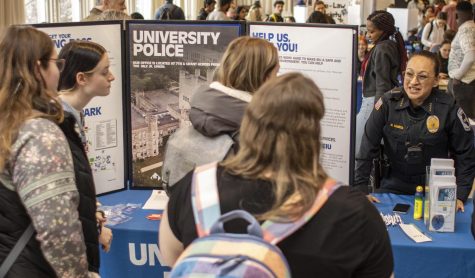UPD gives statistics, ways to prevent sexual assault
April 19, 2023

Statistics pertaining to Eastern’s sexual assault awareness cases allows people to help raise awareness pertaining to sexual violence.
Being aware of the area surrounding someone is one of several ways to prevent sexual assaults or sexual attacks.
Women are more likely to be experience sexual violence than men.
According to icasa.org, one in three women in the United States experience some sort of sexual assault violence in their life, and one in six men are more likely to experience the same types of attacks.
According to the national sexual assault coalition graphic, 20 percent of female students will experience sexual violence while in college, while only six percent of males will experience sexual violence.
The graphic also provided solutions and resources to prevent the acts.
One of the coalitions that are able to assist college campuses is developing and implementing prevention programs. A program can allow people to be informed on the subject and understand what to do in certain situations.
Another solution is to train students, faculty, administrators and faculty on the subject.
Also according to icasa.org, 23 million women in the U.S. have been victim of completed rape of attempted rape at some point. With that, 31% of teenage females have been victims of sexual assault or violence. Additionally, 77% of rape victims were known to their attackers.
According to rainn.org, 463,634 people (age 12 or older) are victims of rape and sexual assault charges in the U.S.
In 2021, according to a Coles County Uniform Crime Reporting Agencies’ Index Crime Offenses statistic, there were two confirmed rape cases at Eastern Illinois University.
University Police Department Chief Marisol Gamboa gave recommendations as to what should be done to prevent being attacked.
Gamboa said being aware of the one’s surroundings, on and off-campus should be a focus along with locking up residences and vehicles, including windows.
“Just be aware you’re aware of your surroundings,” Gamboa said. “Who’s around you, who’s been following you, or if you feel uneasy about a certain person, try to get as far away from them as possible.
Gamboa said having good lighting on the exterior or homes is important as well, and people should walk in well-lit areas.
Gamboa said to use the blue phones located across campus. The blue phones contact the police and lets them know where to go and assist someone.
Gamboa also teaches women’s self-defense classes and recommends people take a class on being safe, male or female.
Resources are available to assist those in need on campus including the counseling clinic or the Sexual Assault Counseling and Informative Service, SACIS.
With people not having roommates, they may have to go out by themselves at night, and while that may be a possibility, Gamboa urges those to inform people on where they are going.
Gamboa also said parking close to the entrance of a building is beneficial in avoiding something happening and carrying a flashlight. She also said not to be distracted while out.
“Don’t be distracted on your phone while you’re walking to your apartment or vehicle because just so many things like [attacks] happen while you’re focused on your phone instead of being aware of what’s around you,” Gamboa said.
She also suggests not wearing headphones or using a transparency mode on certain headphones which allows users to hear what is going on around them while still listening to music.
Having certain products can help prevent attacks from happening. A common item on college campuses are pepper sprays that fit on key rings.
For more information contact [email protected] or call 1-800-656-4673 (HOPE).
Cam’ron Hardy can be reached at 581-2812 or at [email protected].




















































